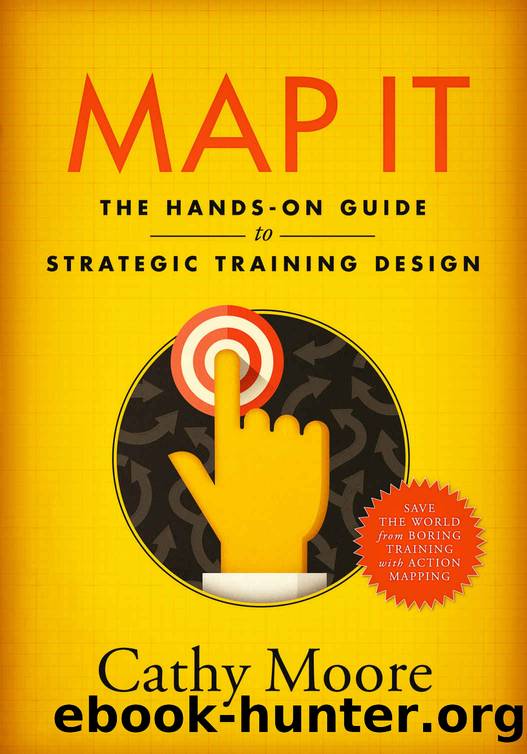Map It: The hands-on guide to strategic training design by Cathy Moore

Author:Cathy Moore [Moore, Cathy]
Language: eng
Format: mobi
Published: 2017-09-17T16:00:00+00:00
Practice during the task?
We had Roger run through some activities right before an interview. It's easy to think of other situations in which practice beforehand would be useful. However, it's harder to imagine a situation in which someone could pause the task to do some practice activities.
Roger can't stop in the interview to practice asking questions. He could hide the information â the PDF of tips â in the folder on his lap and glance at it as if he's looking at his notes. But he can't stop and complete activities.
For other types of tasks, such as data entry, it's possible to stop. But would it be useful to stop mid-task and practice something, or is the person more likely to need information at that point? It depends on the task and the person's prior knowledge.
Remember a procedure: information
Remember Grace and the problem with entering Hispanic names on TPS reports? Let's say that Bonnie, one of Grace's employees, learned how to enter Hispanic names a month ago. Now it's Monday morning after a weekend in which Bonnie had a lot of fun and very little sleep. She's completing a TPS report, and she realizes she's forgotten how to enter Hispanic names.
Does she need a practice activity, or just a reminder of the pattern? I'd say she just needs the reminder. She needs information, not practice. She looks at a small job aid, and once she sees the pattern again, it all comes back, and she's fine.
Learn it for the first time: activity, maybe
Let's say that Bonnie has a new coworker, Sean. He's had no official training. With Bonnie's help and the on-screen tips, he's doing a good job of entering TPS reports. But now he's faced with a Hispanic client who appears to have two last names. Which is the last name for the database?
He asks Bonnie what to do. She sends him a link to the names activity so he can learn the pattern and practice it on several different names. He needs the practice because it's new to him, and because he'll be using the skill repeatedly, both in TPS reports and in conversations with clients. Then he goes back to his work and completes the report.
Would your activity be most useful at the point of need?
If you have some activities that help people practice new or infrequent tasks, consider ways to make them available on demand. The on-demand approach is especially useful for activities that donât have major grey areas and that have consequences that arenât dire.
If instead the task requires a lot of complex decision-making and the fluency that can only come from practice over time, itâs a good candidate for spacing.
How could you space the learning?
"Spacing" refers to helping people practice performing a skill or retrieving information in sessions that are spaced days or weeks apart. Itâs an under-utilized technique that can seriously boost the effectiveness of your activities.
Most corporate training is a one-time event, using the "shot in the arm" approach. We're supposed to
Download
This site does not store any files on its server. We only index and link to content provided by other sites. Please contact the content providers to delete copyright contents if any and email us, we'll remove relevant links or contents immediately.
Hit Refresh by Satya Nadella(9085)
The Compound Effect by Darren Hardy(8873)
Change Your Questions, Change Your Life by Marilee Adams(7689)
Nudge - Improving Decisions about Health, Wealth, and Happiness by Thaler Sunstein(7660)
The Black Swan by Nassim Nicholas Taleb(7063)
Deep Work by Cal Newport(6969)
Rich Dad Poor Dad by Robert T. Kiyosaki(6517)
Daring Greatly by Brene Brown(6476)
Principles: Life and Work by Ray Dalio(6298)
Playing to Win_ How Strategy Really Works by A.G. Lafley & Roger L. Martin(6090)
Man-made Catastrophes and Risk Information Concealment by Dmitry Chernov & Didier Sornette(5958)
Digital Minimalism by Cal Newport;(5707)
Big Magic: Creative Living Beyond Fear by Elizabeth Gilbert(5681)
The Myth of the Strong Leader by Archie Brown(5461)
The Slight Edge by Jeff Olson(5379)
Discipline Equals Freedom by Jocko Willink(5337)
The Motivation Myth by Jeff Haden(5176)
The Laws of Human Nature by Robert Greene(5087)
Stone's Rules by Roger Stone(5053)
